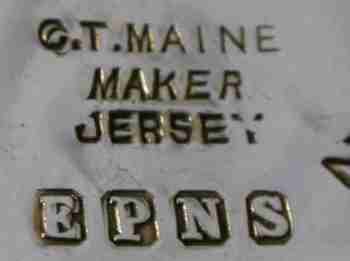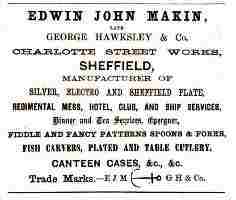ENGLISH ELECTROPLATE SILVER
MARKS AND HALLMARKS OF SHEFFIELD AND BIRMINGHAM SILVER PLATE MAKERS
WITH THE ADDITION OF OTHER BRITISH, SCOTTISH AND IRISH MANUFACTURERS |
This is a page of A Small Collection of Antique Silver and Objects of vertu,
a 1000 pages richly illustrated website offering all you need to know about
antique silver, sterling silver, silverplate, sheffield plate, electroplate silver,
silverware, flatware, tea services and tea complements, marks and hallmarks, articles,
books, auction catalogs, famous silversmiths (Tiffany, Gorham, Jensen, Elkington),
history, oddities ...
SITE MAP - HOME PAGE
|
The two common forms of plated silver are Sheffield plate and silverplate/electroplate.
Sheffield Plate is a cheaper substitute for sterling, produced by fusing sheets of silver to the top and
bottom of a sheet of copper or base metal. This 'silver sandwich' was then worked into finished pieces. At
first it was only put on one side and later was on top and bottom.
Modern electroplating was invented by Italian chemist Luigi V. Brugnatelli in 1805. Brugnatelli used his
colleague Alessandro Volta's invention of five years earlier, the voltaic pile, to facilitate the first
electrodeposition. Unfortunately, Brugnatelli's inventions were repressed by the French Academy of Sciences
and did not become used in general industry for the following thirty years.
Silver plate or electroplate is formed when a thin layer of pure or sterling silver is deposited
electrolytically on the surface of a base metal.
By 1839, scientists in Britain and Russia had independently devised metal deposition processes similar to
Brugnatelli's for the copper electroplating of printing press plates.
Soon after, John Wright of Birmingham, England, discovered that potassium cyanide was a suitable
electrolyte for gold and silver electroplating.
Wright's associates, George Elkington and Henry Elkington were awarded the first patents for electroplating
in 1840. These two then founded the electroplating industry in Birmingham England from where it spread
around the world.
Common base metals include copper, brass, nickel
silver - an alloy of copper, zinc and nickel - and Britannia metal - a tin alloy with 5-10% antimony.
Electroplated materials are often stamped EPNS for electroplated nickel on silver, or EPBM for electroplated Britannia metal.
| THE DIRECTORY OF BRITISH ELECTROPLATED SILVER MAKERS: Ma-Maq |
| SILVERPLATE MANUFACTURERS: MARKS' IMAGE & HISTORY |
| ALPHABETICAL LISTING OF SILVERPLATE MARKS |



MACKAY & CUNNINGHAM
MACKAY CUNNINGHAM & CO
Edinburgh
The firm was active c1824-c1930s. The partnership of James Mackay and David Cunningham was established sometime before 1824 at 40 South Bridge, Edinburgh. Became Mackay Cunningham & Co 'Goldsmiths to the Queen' by 1856, later at 54 Princes Street. In 1873 the firm was recorded as 'Goldsmiths to the Queen, HRH Prince of Wales, watchmakers, and manufacturers and designers of Scottish jewellery'. Taken over by James Hardy & Co. Ltd. by 1912. |

MACLAURIN & DENNIS
Sheffield
No information found |

MACLAURIN BROTHERS
Sheffield
Active at Sidney Works, 23-20 Sydney St, Sheffield (1871-1925). The firm was founded by the sons of
James Maclaurin owner of James Maclaurin & Sons, Boston Works, 70 Bowden St, Sheffield (1865-1870) |

GEORGE MACLAURIN
GEORGE MACLAURIN & SON
GEORGE MACLAURIN & SON LTD
Sheffield
Active at 66 Cecil Road and 117 Matilda St, Sheffield |


HERBERT MACLAURIN
Sheffield
Herbert Maclaurin (born 1865) active at Matilda Works (1894-1915) and Sylvester St, Sheffield
(1916-1923). Succeeded in 1894 to his father George Maclaurin (born 1839) working in Matilda Works since 1881
(formerly belonging to Wolstenholme & Biggin). The firm used the trade mark INTRINSIC |

CHARLES T. MAINE
Jersey
A retailer jeweller, optician, and watch and clock repairer. In 1890 he purchased the business of H. Holinshed (formerly John Le Gallais). The business
continues in the same family |


EDWIN JOHN MAKIN
Sheffield
Charlotte Street Works. Succeeded to George Hawksley & Co |
E.P.N.S. (Electroplated Nickel Silver) and EPBM (Electroplated Britannia Metal) are the most
common names attributed to silver plate items. But many other names are used for silver plate:
EPWM - Electroplate on White Metal, EPC - Electroplate on Copper, Argentium, Argentine Plate, Argentum,
Ascetic, Austrian Silver, Brazilian Silver, Buxbridge, Electrum, Encore, Exquisite,
Insignia Plate, Nevada Silver, Norwegian Silver, Pelican Silver, Potosi Silver,
Silverite, Sonora Silver, Spur Silver, Stainless Nickel, Stainless Nickel Silver, Venetian Silver, W.M White Metal,....
|
| WORLDWIDE DIRECTORY OF SILVERPLATE MANUFACTURERS: HISTORY & MARKS |
| BRITISH TOWN MARKS AND DATE LETTERS |
STERLING SILVER OF ENGLAND, SCOTLAND AND IRELAND
ALPHABETICAL LISTING OF MAKER'S MARKS |

www.silvercollection.it |
This is a page of 'The What is? Silver Dictionary' of A Small Collection of
Antique Silver and Objects of vertu, a 1500 pages richly illustrated website offering all you need to know about
antique silver, sterling silver, silverplate, Sheffield plate, electroplate silver,
silverware, flatware, tea services and tea complements, marks and hallmarks, articles,
books, auction catalogs, famous silversmiths (Tiffany, Gorham, Jensen, Elkington),
history, oddities ...
HOME -
SITE MAP -
SILVER DICTIONARY -
COOKIES CONSENT AND PRIVACY |
These pages were useful? leave your LIKE on
facebook
|
work in progress on this page - your help, corrections and suggestions will be greatly appreciated -
|